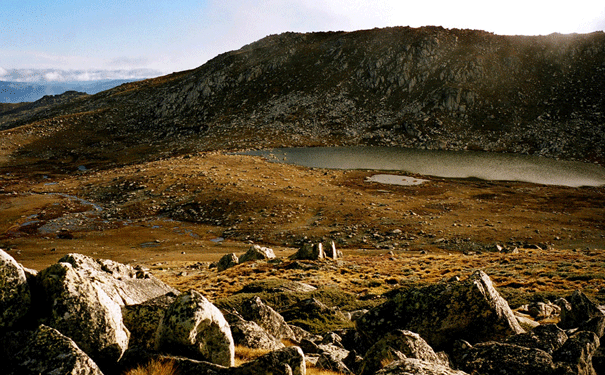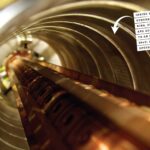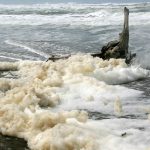
The glacial Lake Cootapatamba greets hikers approaching the Kosciuszko summit. Image: Matthew Abbott
It should have taken a week to finish an overland journey across Australia’s alpine region — instead, it took a decade.
Why humans feel the need to climb mountains is one of life’s unanswered mysteries. It could be the instinctive need to keep ticking off achievements, or the thrill of the unknown, or simply, as the great Everest explorer George Mallory once said, “because it is there”.
After five hours and many more kilometres traipsing through the late autumn drizzle in Kosciuszko National Park, my own reason for climbing finally comes into focus in the form of a dark block of stone silhouetted on the ridge ahead. It’s been more than ten years since I’ve walked across the timber floor of Seaman’s Hut, and I’m not sure what to expect.
It hasn’t changed. The solid sandstone cladding, aided by a squat black potbellied stove and a pile of wood stacked higher than my head, blissfully blocks out the cold. The hatch pattern of the divided windows cast a weak series of sunlight blocks on the floor. Outside, there is nothing but white haze and the sound of the howling winds tormenting the mountains. The only thing that has really changed in this picture is me. This time, I walked through the door instead of falling through it. My body is warm instead of critically cold, and there’s no weathered mountain fire truck waiting on the road outside. While I have no desire to compare my meager efforts to that of more illustrious climbers, I feel the same affectation of stubbornness wash over me. My last attempt to cross these mountains was a near-disaster, ending early when a freak summer storm shattered our carefully laid plans to summit the tallest mountains on the range. I came back to prove I could finish.
Moody beginnings
It’s easy to be misled by Australia’s snowy mountains. In the warmer months, gently undulating hills, unique wildlife and the fleeting attraction of a glimpse of snow draw hundreds of hikers. Despite being the country’s tallest mainland mountain, Kosciuszko can be summitted by young and old. To seasoned mountaineers, the Snowies are neither high nor tough; a novel disruption to a country filled with deserts and low-lying bushland. Yet the weather can change suddenly and with little warning, and when that happens, only preparation and a little luck can offer the hope of survival. For some, that has been a lesson learned too late.
The mountain range claimed its first lives more than 80 years ago when an American, Laurie Seaman, and his skiing partner Evan Hayes became separated from their group during a blizzard. A member of their party, Emil Soderstein, described the repeated and eventually futile attempts to locate the pair to the Sydney Morning Herald that day. “The sleet cut into our faces. We could not see any distance ahead… with difficulty we reached Charlotte Pass hut. It was snowed up, so we dug our way in, and then began to thaw out our hands, which were swollen and frozen.”
Soderstein’s words have timeless relevance. Year after year, the mountains brood with unpredictable storms and lashing winds, year after year emergency teams are dispatched to rescue stranded hikers battered by the weather. Poor visibility, remoteness and sweeping storms make search operations difficult and dangerous. The unrelenting weather was a death sentence for Seaman and Hayes. Although searchers spotted their tracks on icy snow leading down an incline on the day they disappeared, the pair were never found alive. More than a month later, Seaman’s body was discovered by a group of schoolboys and their teacher near the Kosciuszko summit. It took another 16 months before the grisly discovery of Hayes’ skeleton was made behind a rock cluster nearby.
It’s a small comfort that Seaman’s Hut, constructed with funding from the lost skier’s family, has since been a refuge for many hikers. The cabin’s log tells other stories — hundreds of them — of past travellers caught out by the weather. Every one is different, but they all sing the same song of delight at stumbling upon this tiny shelter. Simple things, like a place to boil water and a place to dry one’s socks are the things of value here. After many hours of trekking in temperatures close to zero and the ever-present, burning wind, food and warmth become the most important things in the world. Like the brick-red Cootapatamba Hut on the southern side of Kosciuszko, Seaman’s Hut was built above the snowline for the singular purpose of survival.
The group I set off with more than a decade ago were far from seasoned, most of us not yet sixteen, but we were used to being flung into the wilderness with a map, a compass and a tent. School had ended for the year and summer was everywhere. We walked for days through the swampy, spongy terrain as the weather steadily grew worse. When night fell on what was meant to be our last evening camping in the Snowies, huge winds blasted the mountains. One particularly unfriendly gust sent my half-constructed tent barelling into a lake. It took a miserable twenty minutes to fish out the slimy thing, and the cold dark night that followed brought rest to few. Morning was subdued. The brumbies who greeted us on lowlands some 50 kilometres past had long gone. Getting back to camp should have been a simple task. We had older, experienced trekkers guiding us, a full day of light ahead, and we were less than 10 kilometres from our final destination. Then the weather took yet another turn for the worse, and we found ourselves in total white-out conditions. Those in front of me turned pale like ghosts before disappearing altogether into the dense fog. Three members of our group went down silently with core temperatures plummeting to dangerous levels. In a fit of shivering and with a stream of incoherent words, I was one of them. What happened next is fuzzy, but I do remember one thing: Seaman’s Hut saved my life.
All this comes back to me like a dream while staring out the window of the old survival hut. Dirty, sand-coloured walls emerging like a beacon in a sea of white — that first glimpse of Seaman’s Hut is burned in my mind.
A second approach
Our return trip should have been a breeze. We are older, wiser and more experienced, but most importantly we have a car and a warm hotel room waiting for us instead of a wet tent and serious boot-leather to burn.
That hadn’t stopped me from feeling hesitant as we stepped out of the car in the foothills of the Snowies to start the journey all over again.
The weather in the region had been moody for weeks, swinging from torrential downpour to gale-force winds and back again. Plans of an early-morning departure had to be scrapped as sheets of icy water washed down the windows. Rugged up in thick layers, we waffled the morning away in a local bakery and stared out the window at the sky, hopeful for a tiny patch of blue. We knew, though, that the high country was once again off-limits. Biting winds of up to 120 kilometres an hour made the mountains a no-go zone. After some deliberation we’d changed course and headed west, hoping to outrun the rain and, at the very least, catch a glimpse of the peaks from afar.
The road to Khancoban
A series of hairpin turns along Alpine Way takes you all the way to the Murray and the New South Wales-Victoria border. There, the road turns at a sharp right-angle and heads north to Khancoban. It’s a pleasant, sparsely populated route where farmlands and fishing spots form most of the landmarks. We had passed wet alpine forests with giant eucalypts and mountain ash trees, heavy and foreboding in the inclement weather. High above our heads they had swayed in a gruesome dance of distress, littering the road below with branches and debris.
By the time we reached the township of Geehi, the sun was shining and the storm had gone. This was grazing country, gently sculpted green land dotted with a series of old weather-beaten huts, some lovingly restored by locals. Geehi hut is an impressively solid specimen made from river stones, concrete and dirt, nestled next to Swampy Plains River, a popular trout-fishing area.
When we arrived, there were no such visitors. A large herd of kangaroos grazed nearby, peering carefully at us on approach before bounding into the long grass. This hut and others in the low-lying district are little more than tributes to the past, off-limits to overnight visitors. Beside Geehi sits another such example: Tyrell’s Hut, a standing ruin originally built for shepherds.
The Geehi valley, like its history, was picturesque and quiet. Late in the afternoon we discovered Olsens lookout, built for Queen Elizabeth II more than half a century past. The view we saw was fit for royalty: a full, glowing rainbow accenting the main range, which was shaded in dark green behind it. These were the mountains that had now twice escaped me. As darkness cloaked the valley, I knew beyond doubt that I had to try again.
Onwards and up
The next morning dawned quietly; a wonderfully positive sign. We drove a full hour to Charlotte’s Pass, disembarking near the top of some empty ski-lifts. A brisk four degrees and calm skies were our waiting reward.
The highest and toughest trees in Australia call this frozen wilderness their home. As winter approaches, the beautiful and twisted alpine eucalypts shed their silver and outermost bark, revealing inner layers of pink, red and cream. We set off on the track, startling something bushy and blonde in the scrub ahead, a fox perhaps; we could only guess.
There are many ways to tackle the high country, but the old Kosciuzsko Road follows a ridge to the summit, a popular and relatively safe option. It’s not the adventurous route I would have picked in the past, but this time it seemed like the right way to go.
After a slow dip to the Snowy River the track climbs again, dispensing you from the treeline into the proper alpine zone. There are scarce few signs of life in the true alpine region. The tortured gums fall away and somewhere under the sphagnum moss, you might catch the sound of unseen frogs croaking and gurgling softly to each other. Then, you press higher, until there is nothing.
We had debated taking an alternate path across the main range track, crossing the Snowy River at a series of stone markers and heading for the bright shores of Blue Lake some five kilometres to the north. Only once we had reached the higher plains and looked down at the swollen river did it become clear the stone crossing would have been worse than futile. The river was higher than it appeared, gushing furiously after weeks of torrential rain. For a moment I could see history repeating; Allowing ourselves to get cold and wet was the primary reason our trip turned so ill-fated all those years ago.
The fatal flaw avoided, we headed up the mountain one last time — and for once, nothing was standing in our way. As our final destination crept closer, the sun had blasted through clouds with one last mighty effort. The sunlit valley shone with a full spectrum of colours, from forest green to blazing purple. It was nothing less than stunning.
The final descent
Once we finally ensconced ourselves within the safety of Seaman’s Hut, it was very hard to leave. Rocky Townsend loomed to the left, and Kosciuszko to the right, but for me at least, neither held the same appeal of being back in this true place of survival. I gazed at the black-and-white portraits of Seaman and Hayes on the walls as I coaxed feeling back into my frozen hands. They’ll never know the legacy they left behind.
Before we leave the mountain we make one final stop, continuing along the track to the base of Kosciuszko. Here we find the dark and elegant Lake Cootapatamba, a shimmering blue-grey vista hiding under an intimidating pile of rocks. Beyond the lake, a tiny speck of red leaps out on the horizon. This is Cootapatamba Hut, another life-saving construction built to catch climbers heading the wrong way off the ridge, towards many kilometres of wilderness. We head down the mountain feeling quiet and content. In total contrast to the morning’s furious rush, a gentle sunset shrouds the mountain, bringing with it the promise of clear skies and a calm night.
Just as I am feeling like age brings wisdom, and perhaps cures some reckless instinct to explore at all costs, a pair of wizened faces appear on the horizon. As they get closer we see two men who must be pushing eighty, faces lit like schoolboys skiving off school. They’re going full pelt in the wrong direction, straight up the mountain in the final moments of the day’s dying sunlight. We stare at them, wondering what would cause these old blokes to tackle the mountains with such reckless abandon. They pull faces back at us, hooting with laughter as they dash off on some unknown adventure. I can’t help but smile at their enthusiasm — maybe some things never get old.
To find out more about Rhiannon’s journey, grab a copy of Issue 6






